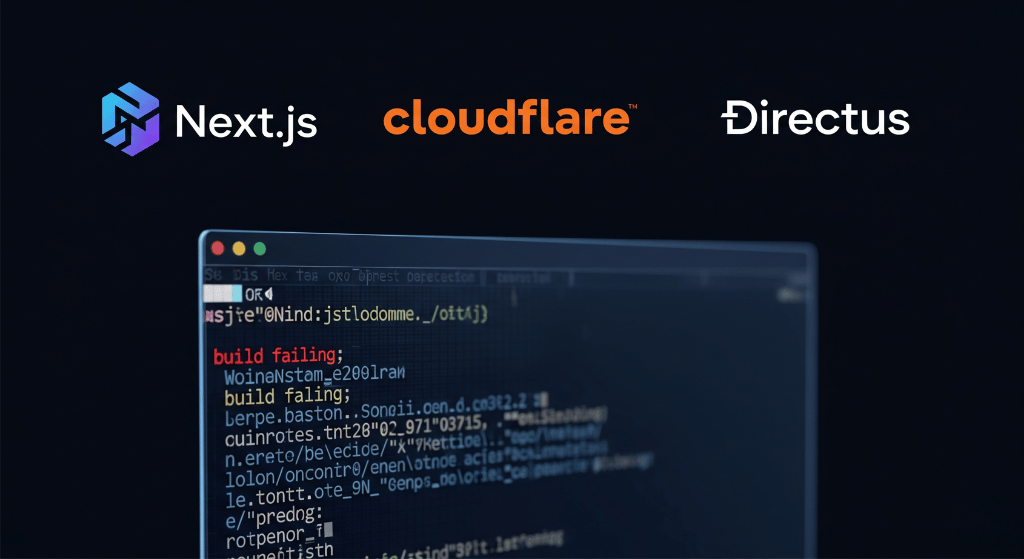By Shyam Verma —
Cloudflare + Directus Proxy Debugging

Next.js static generation randomly failing during npm run build with no server logs. Here's how to debug invisible network issues and implement a reliable solution.
Problem: Silent Build Failures
$ npm run build
> reelabilities@1.0.0 build
> next build
- info Linting and checking validity of types
- info Creating an optimized production build
- info Compiled successfully
- info Collecting page data .
× Failed to collect page data for /toronto/films/[slug]
Error: fetch failed
at Object.fetch (node:internal/deps/undici/undici:11457:11)
at async fetchFilmById (/app/.next/server/chunks/123.js:1:234)
Symptoms:
- Development: ✅ Perfect
- Runtime: ✅ Perfect
- Build time: ❌ Random failures
- Server logs: 📝 Empty
- CDN logs: 📝 Empty
Diagnosis
# Directus container logs - nothing suspicious
docker logs directus-container -f --tail=100
# Caddy reverse proxy logs - clean
docker logs caddy-container -f --tail=100
# Cloudflare dashboard - security events empty
# Analytics dashboard - no unusual traffic patterns
Root Cause: Cloudflare's bot protection silently blocking build-time API requests.
Evidence:
- Build-time requests are concurrent and automated
- CDN security treats this as suspicious traffic
- No logs because blocks happen at edge level
Solution: /etc/hosts Bypass
Bypass Cloudflare during builds while keeping it for runtime traffic.
# /etc/hosts
YOUR_SERVER_IP cmsdomain.com
Server Configuration:
# Caddyfile - Handle direct HTTPS with IP restrictions
cmsdomain.com:443 {
# Restrict access to build server IP only
@allowed remote_ip YOUR_BUILD_SERVER_IP
handle @allowed {
reverse_proxy directus:8055
}
# Deny all other IPs
handle {
respond "Access Denied" 403
}
# TLS handled by Caddy with Let's Encrypt
tls your-email@domain.com
# CORS headers for API access
header Access-Control-Allow-Origin *
header Access-Control-Allow-Methods "GET, POST, PUT, PATCH, DELETE, OPTIONS"
header Access-Control-Allow-Headers "Authorization, Content-Type, Accept"
# Handle preflight requests
@cors_preflight method OPTIONS
respond @cors_preflight 204
}
# Still handle Cloudflare traffic on standard port (no IP restrictions for public access)
cmsdomain.com:80 {
reverse_proxy directus:8055
}
Build Environment:
# Build environment variables
NODE_ENV=production
CI=true
DIRECTUS_URL=https://cmsdomain.com
# Critical: Allow insecure SSL connections for direct server access
# This bypasses SSL certificate validation during builds
NODE_TLS_REJECT_UNAUTHORIZED=0
// Build-time API configuration
const DIRECTUS_URL = process.env.NODE_ENV === 'production' && process.env.CI
? 'https://cmsdomain.com' // Direct to server during builds
: process.env.DIRECTUS_URL; // Regular runtime configuration
export const directus = createDirectus(DIRECTUS_URL)
.with(authentication())
.with(rest());
Results
$ npm run build
> reelabilities@1.0.0 build
> next build
✓ Linting and checking validity of types
✓ Creating an optimized production build
✓ Compiled successfully
✓ Collecting page data
✓ Generating static pages (247/247)
✓ Finalizing page optimization
Build completed successfully!
100% build success rate.
Production Setup
# CI/Build server /etc/hosts
YOUR_SERVER_IP cmsdomain.com
# Build environment variables
NODE_ENV=production
CI=true
DIRECTUS_URL=https://cmsdomain.com
# Critical for direct server access
NODE_TLS_REJECT_UNAUTHORIZED=0
Caddy Config:
cmsdomain.com {
# IP restriction for build server access
@build_server remote_ip YOUR_BUILD_SERVER_IP
handle @build_server {
# Handle build server traffic (bypassing Cloudflare)
reverse_proxy directus:8055 {
# Optimize for build-time requests
timeout 30s
header_up Host {upstream_hostport}
header_up X-Forwarded-Proto {scheme}
}
}
handle {
# Handle regular traffic through Cloudflare
reverse_proxy directus:8055 {
timeout 30s
}
}
# Compression
encode gzip
# CORS
header Access-Control-Allow-Origin *
header Access-Control-Allow-Methods *
header Access-Control-Allow-Headers *
}
Final Results
- 100% build success over 3+ months
- Faster builds (no CDN latency)
- Security maintained (IP restrictions)
- Runtime performance unchanged
Debug Methodology
- Eliminate layers systematically
- Use /etc/hosts for CDN bypass testing
- Check build vs runtime contexts
- Monitor patterns, not just individual failures
- Test in isolated environments
Key Takeaways
- CDN bot protection can be invisible and inconsistent
- Build-time traffic patterns differ from user traffic
/etc/hostsis the fastest way to isolate CDN issuesNODE_TLS_REJECT_UNAUTHORIZED=0works for controlled environments- Dual-stack approaches let you optimize per context
Common Signs of CDN Interference
- Works in development, fails in CI
- Intermittent failures with no server logs
- Concurrent requests failing more than sequential
- Different behavior across CDN edge locations